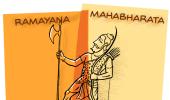'With doctors going up against a seemingly invincible enemy, often at immense risk to their lives, the myths reveal an interesting relationship between the men of medicine and the rest of humankind,' notes Arundhuti Dasgupta.
Illustrations Uttam Ghosh/Rediff.com

In the fear and panic created by the spread of COVID-19, one profession that has been thrown into sharp relief is that of health professionals -- doctors, nurses, attendants and the like.
In mythologies across the world, this profession has been ascribed magical powers and its practitioners have been accorded divine status.
In their present avatar, with doctors going up against a seemingly invincible enemy, often at immense risk to their lives, the myths reveal an interesting relationship between the men of medicine and the rest of humankind.
On the one hand, they are a grim reminder of the important role that healers and medicine men have played since the beginning of time.
On the other, the stories also reveal the limits and sometimes the dark side of their power.
In many cultures, medicine men were among the most important gods and spirits.
Many were also children of the sun god, since the sun was believed to have regenerative powers.
Asclepius, the Greek god of medicine, was the son of Apollo and a mortal, a princess named (ironically, in the age of the coronavirus) Coronis.
Asclepius had an eventful entry into the world.
His mother died in labour and his father had to cut the unborn child from her womb.
The centaur Chiron, guide and mentor for many heroes in Greek myth, taught him the art of medicine.
Asclepius earned renown for being able to restore the dead to life.
But his mastery of the craft was seen as going against the natural order and Zeus stepped in to remind him of his limits.
He destroyed Asclepius with a thunderbolt but did not take away his divine status.
In India, there are several gods of medicine and healing.
The Asvins, twin sons of Surya, are one such pair.
Their attributes are numerous, but relate mostly to youth and beauty, light and speed, duality, the curative power, and active benevolence.
They are the physicians of heaven and their claim to fame (apart from fathering two Pandavas, Sahadeva and Nakula) is that they could reverse age.
Bringing back the dead, however, was beyond their ken.
The power to restore life belonged to the guru of the asura clan, Shukracharya.
He knew the mantra of immortality, which meant that the asuras were invincible in battle.
The gods were naturally unhappy and contrived the end of Shukracharya, and he was finally destroyed in an elaborate myth of love, deceit and immortality.
Although the power of healing was considered a divine blessing, the gift came with strings attached.
Healers were given a place in prayer and ritual in many cultures, but they were also punished for their transgressions and in some cases painted in deep shades of grey.
The dual nature of healer gods and spirits is typical of all ancient gods, indicating that the power to cure was clearly among the most sought-after, much like the power to control weather, provide food and create life.
So, fear and reverence combined together; interestingly, a similar sentiment infused the relationship that ancient men had with the community of human healers too.
Shamans from various parts of the world were seen as men of magic and sorcery as were witches whose medicinal brew could cure or kill.
The power of healing in many communities is also seen as a gift from the animal world.
In South America, the most powerful shamans are those that identify with the region's most powerful predator, the jaguar.
Their powers are dependent on their ability to propitiate their mentor god and they wear necklaces of jaguar teeth and dress in jaguar skin when they set out to heal and cure people.
Mircea Eliade, one of the earliest scholars to study shamanism, wrote that the magico-religious life of ancient societies gave primacy of place to the figure of the shaman.
He describes a shaman as being 'at once magician and medicine man, healer and miracle-doer, priest, mystic, and poet.'
In many cultures in South America, a shaman remains all-powerful; even after his death he turns into the soul of his alter-ego, the jaguar.
The mythological imagination often looks at body and soul as a fused entity.
Frequently, the soul is believed to be an invisible duplicate of the physical body and in some cases is also believed to be the essence that makes up the shadow or a shadow self.
That is why in Africa and in many parts of India, healers and witches can cure or inflict injury and death by attacking their victims's souls.
But disease is never only of the body, it affects the soul too.
Today in the fight against the coronavirus, this is in full evidence yet again.











